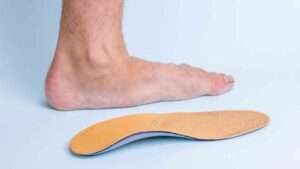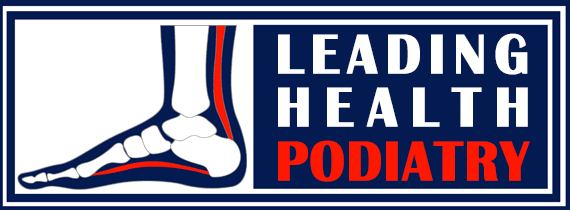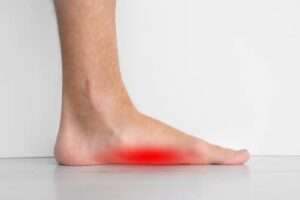Flat Feet in Adults
At Leading Health Podiatry, we understand how flat feet can impact your daily life. Flat feet, also known as fallen arches, occur when the arches of your feet collapse, causing the entire sole to touch the ground. Whether you’ve had flat feet since birth or developed them later due to injury, aging, or other factors, our team is here to help you manage the condition and reduce discomfort.

What Causes Flat Feet?
Flat feet can develop for several reasons:
- Genetics: Many people are born with flat feet, meaning they lack the natural arch from the start.
- Injury: Damage to tendons or ligaments from a foot injury can cause the arch to collapse.
- Aging: As you age, the tendons supporting your arch may weaken, leading to flat feet.
- Pregnancy: Hormonal changes during pregnancy can loosen ligaments, sometimes causing the arch to flatten.
- Obesity: Excess weight puts added pressure on your feet, which can cause the arch to flatten over time.
- Medical Conditions: Conditions like arthritis or diabetes can contribute to the development of flat feet.
Recognizing the Symptoms of Flat Feet
Flat feet may lead to various symptoms, including:
- Foot, arch, or heel pain: Discomfort after long periods of standing or walking is common.
- Swelling in your feet or ankles: This may occur due to pressure on the feet from the lack of arch support.
- Tired, fatigued feet: If you have flat feet, your feet may feel sore or exhausted more quickly.
- Difficulty walking or standing: You may notice pain when participating in physical activities.
- Pain in the knees, hips, or lower back: Flat feet can affect your overall posture and alignment, leading to pain elsewhere in your body.
How We Diagnose Flat Feet
At Leading Health Podiatry, we offer a thorough diagnosis to determine if flat feet are the cause of your discomfort:
- Physical Examination: We will examine your feet, ankles, and legs to assess the alignment and identify any issues related to flat feet.
- Foot Imaging: In some cases, we may use X-rays or other imaging tools to assess the bone structure and alignment of your feet.
- Gait Analysis: Observing how you walk helps us identify any changes in your movement caused by flat feet.
Treatment for Flat Feet at Leading Health Podiatry
We understand that flat feet can affect your quality of life, but with the right care, you can manage the condition effectively. At Leading Health Podiatry, we offer personalized treatments to reduce pain and improve mobility:
- Custom Orthotics: Our custom-made insoles provide arch support, reduce pain, and help improve your posture and alignment.
- Footwear Advice: Choosing the right shoes with proper arch support is key. We’ll guide you on selecting footwear that works for your specific needs.
- Stretching & Strengthening Exercises: Specific exercises can help improve muscle strength and flexibility, reducing pain and preventing the condition from worsening.
- Physical Therapy: In some cases, physical therapy can help improve your overall mobility and alignment.
- Surgery: For severe cases of flat feet that do not respond to conservative treatments, surgical options may be considered.
When to See a Podiatrist for Flat Feet
If you experience pain or discomfort in your feet, knees, or lower back, or if you notice changes in your walking pattern, it’s important to seek care. Early treatment can help prevent further complications. At Leading Health Podiatry, we are here to provide you with the best solutions to manage flat feet and improve your quality of life.
Conclusion
Flat feet can lead to discomfort, pain, and postural issues, but with the right care, you can manage the condition effectively. At Leading Health Podiatry, we offer personalized treatments like custom orthotics, stretching exercises, and footwear advice to help you feel your best. Contact us today to schedule an appointment and take the first step towards healthier feet and a more comfortable life.

